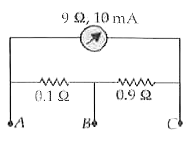In the previous question, if A and C are used as terminals, with B isolated, full-scale isolated, full-scale deflection is obtained for a current of.
90 mA
100 mA
900 mA
1A
The correct Answer is:B

(I−10×10−3)×(0.1+0.9)=9×10×10−3
I=100×10−3A
=100mA.
Topper's Solved these Questions
Similar Questions
A galvanometer with a coil resistance of 100Ω shows a full-scale deflection when a current of 1 mA is passed through it. What is the value of the resistance which can convert this galvanometer into an ammeter showing a full-scale deflection for a current of 10A?
A resistance of the required value is available but it will get burnt if the energy dissipated in it is greater than 1W. Can it be used for the conversion of the galvanometer described above? [Hint:Power dissipated =I2watt)
View Solution(a) Briefly explain how a galvanometer is converted into an ammeter.
(b) A galvanometer coil has a resistance of 15Ω and it shows full scale deflection for a current of 4 mA. Convert it into an ammeter of range 0 to 6 A.
View Solution
Knowledge Check
A galvanometer with a coil of resistance 50Ω shows full-scale deflection when 10 mA current passes through it.
AThe galvanometer can measure a maximum voltage of 0.5 V.B5 A current can be measured if a shunt of 0.1Ω is connected in parallel to it.CIt can be used as voltmeter to measure a voltage of 5 V if 450Ω resistance is connected in series with the coil of the galvanometer.DIt can be used as a voltmeter to measure a voltage of 50 V if 4,950Ω resistance is connected in series with the coil of the galvanometer.A galvanometer having a coil resistance of 100ω gives a full scale deflection , when a current of 1mA is passed through it. The value of the resistance, which can convert this galvanometer into ammeter giving a full scale deflection for a current of 10A , is :
A0.1ωB3ωC0.01ωD2ωA galvanometer having a coil resistance of 100 Ω gives a full scale deflection, when a current of 1 mA is passed through it. The value of the resistance, which can convert this galvanometer into ammeter giving a full scale deflection for a current of 10 A, is
A0.1ωB3ωC0.01ωD2ω
A galvanometer having a coil resistance 100Ω given full scale deflection when a current of 1mA is passed throught it . What is the value of the resistance which can convert this galvanometer into a voltmeter giving full scale deflection for a potential difference of 10 V ?
View SolutionA galvanometer with a coil resistance of 100Ω shows a full-scale deflection when a current of 1 mA is passed through it. What is value of the resistance which can convert this galvanometer into an ammeter showing a full scale deflection for a current 10 A? A resistance of the required value is available but it will get burnt if the energy dissipated in it is greater then 1 W. Can it be used for the conversion of the galvanometer described above?
View SolutionA milliammeter of range 10mA and resistance 9Ω is joined in a circuit as shown. The metre gives full-scale deflection for curretn I when A and B are used as its terminals, i.e., current enters at A and leaves at B (C is left isolated). The value if I is

View SolutionA milliammeter of range 10 mA and resistance 9 Ω is joined in a circuit as shown in the figure. The metre gives full scale deflection for current / when A and B are used as its terminals, i.e., current enters at A and leaves at BC is left isolated). The value of /is

View SolutionA galvanometer of resistance 30 2 is connected to a battery of emf 2 V with 1970 Q resistance in series. A full scale deflection of 20 divisions is obtained in the galvanometer. To reduce the deflection to 10 divisions, the resistance in series required is
View Solution
